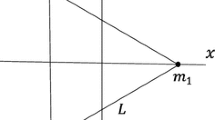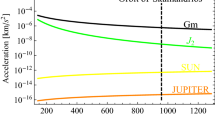Abstract
In the restricted three-body problem, it is found that there are five points where the gravitational forces on the small body balance the centrifugal force. These points are the singular points of the differential equations of motion and can also be seen as double points of the zero-velocity surfaces. For small deviations from the Lagrange point the equations of relative motion may be considered to be linear in the deviations, and it is then found that the motion consists of two periodic motions with periods of about 28.6 and 92 days. In. this paper this same motion is considered as it is perturbed by the sun. The equations of motion of a planar restricted four-body problem (i. e., circular moon orbit and circular orbit of earth-moon barycenter around the sun, zero inclination between moon and sun orbits) are first written in terms of Jacobi coordinates. The Hamiltonian consists of two parts: one leads to the restricted three-body problem and the other introduces the sun’s perturbations. This latter part, which has (mass of sun/R3(earth-sun)) as a factor, consists of the usual sequence of Legendre polynomials of the angle between the radii to the particle and the sun and “coupling” terms, which also contain the mass of the moon and the angle between the radii to the particle and the moon. The equations of motion with respect to the Lagrange point are then obtained by using the constant and linear parts of the series expansion of the Hamiltonian near the Lagrange point. Even though the second Legendre Polynomial in the sun’s perturbing function is 400 times smaller than the first, it is retained because it gives rise to a near resonance due to the closeness of the shorter fundamental period of the three-body solution to the synodic month. The “coupling” term, however, is not used; it is about 30 times smaller than the second Legendre polynomial. The ensuing equations are solved by the method of Laplace transforms, up to the first power bf the parameter (mass of sun/R3(earth-sun)). Good correspondence is shown between this solution and a numerical integration of the restricted four-body problem. The agreement with a numerical integration using ephemeris positions of sun and moon and referring the motion to the “elliptical” Lagrange point is less favorable. An attempt to explain this discrepancy is made by solving the equations of motion with respect to the elliptical Lagrange point (which is a point always 60° ahead of, and at the same distance as the moon, while the moon is assumed to move in an elliptical orbit) to include the square of the eccentricity of the moon’s orbit. Although the formulation of this problem in terms of rectangular coordinates clearly has some serious limitations, it does suffice to show some of the salient leatures of this interesting problem as, for instance, the relative sizes of different effects and the resonance problems. The present work will serve as an excellent basis for a more comprehensive perturbation analysis in terms of canonical variables.
Résumé
Dans le probléme restreint des trois corps, on trouve qu’il y a cinq points ob les forces de gravitation sur le petit corps balancent la force centrifuge; ces points sont les points singuliers des équations différentielles de mouvement et peuvent aussi étre considérés comme doubles points des surfaces de vélocité zéro. Dans le cas de petites déviations du point de Lagrange, les équations du mouvement relatif peuvent ttre considérées linéaires dans les déviations et on trouve alors que le mouvement consiste en deux mouvements périodiques avec des périodes d’environ 28, 6 et 92 jours. Dans cette étude, ce méme mouvement est considéré quand il est perturbé par le Soleil. Les équations du mouvement dans le probléme restreint de quatre corps dans un plan (c.à d. orbite circulaire de la Lune et orbite circulaire du barycentre Terre-Lune autour du Soleil, inclination zéro entre les orbites de la Lune et du Soleil) sont d’abord écrites en termes de coordonnées de Jacobi. L’Hamiltonien consiste en deux parties: l’une conduit au probléme restreint des trois corps et l’autre introduit les perturbations du Soleil. Cette dernihre partie, qui a (masse du Soleil/R3(Terre-Soleil)) comme facteur, consiste en l’usuelle séquence des polynômes de Legendre de l’angle entre les rayons h la particule et au Soleil et les termes “accouplès” qui contiennent aussi la masse de la Lune et l’angle entre les rayons à la particule et à la Lune. Les équations du mouvement par rapport au point de Lagrange sont alors obtenues en employant les parties constantes et linéaires du développement en série de l’Hamiltonien au voisinage du point de Lagrange. Quoique le second polynôme de Legendre dans la fonction perturbatrice du Soleil soit 400 fois plus petit que le premier, il est retenu parce qu’il donne naissance à une presque résonance, due à la proximité de la plus courte période fondamentale de la solution des trois corps au mois synodique. Le terme “accouplé” cependant n’est pas employé; il est environ 30 fois plus petit que le second polynôme de Legendre. Les équations dérivées sont résolues par la méthode des transformations de Laplace, jusqu’à la premibre puissance du paramètre (masse du Soleil/R3(Terre-Soleil)). Un bon rapport est montré entre cette solution et une intégration numérique du problème restreint des quatre corps. L’accord avec une intégration numérique employant des positions éphémérides du Soleil et de la Lune et se répérant le mouvement au point elliptique de Lagrange est moins favorable. Un essai pour expliquer cette contradiction est fait en résolvant les équations du mouvement par rapport au point elliptique de Lagrange (qui est un point toujours en 60° en avant de la Lune et à la même distance que la Lune tandis que la Lune est supposée se mouvoir dans une orbite elliptique) comprenant le carré de l’excentricité de l’orbite de la Lune. La formulation de ce problème en termes de coordonnées rectangulaires évidemment a de sérieuses restrictions, mais elle suffit à montrer quelques-uns des traits saillants de cet intéressant problème comme, par exemple, les dimensions relatives des différents effets et les problèmes de résonance. Le présent travail servira d’excellente base pour une plus complète analyse de la perturbation en termes de variables canoniques.
абстрактный
В ограниченной задаче трех тел существует пять точек, в которых силы притяжения на малое тело уравновешаются центробежной силой. Эти точки являются особыми точками дифференциальных уравнений движения. Их также можно рассматривать как двойные точки поверхностей, на которых относительная скорость обращается внуль. Для малых отклонений Лагранжевых точек уравнения относительного движения линейны в отклонениях. Движение состоит тогда из двух периодических движений с периодами приблизительно в 28.6 и 92 дня. Этот доклад посвящен рассмотрению влияния солнца на вышеуказанные движения. Уравнения движения ограниченной плоскостной задачи четырех тел (круговая орбита луны, круговая орбита центра тяжести системы земля-луна вокруг солнца, нулевой наклон между орбитами солнца и луны, движение всех тел в плоскости) записываются в координатах Якоби. Гамильтониан состоит из двух слагаемых. Первое ведет к ограниченной задаче трех тел, в то время как второе вводит возмущения солнца. Последнее слагаемое содержит множитель, состоящий из отношения массы солнца к кубу расстояния земли от солнца. Этот множитель выражается обычной последовательностью полиномов Лежандра от угла между радиусом, направленным к частице, и радиусом, направленным к солнцу. Вторая часть содержит также члены, содержащие массу луны и угол между направлениями к частице и луне. Уравнения движения относительно Лагранжевой точки получаются, если взять постоянный член и линейные члены разложения Гамильтониана вблизи Лагранжевой точки. Следует отметить, что полином Лежандра второго порядка, учитывающий возмущения от солнца, в четыреста раз меньше полинома первого порядка. Тем не менее, он учтен, так как он приводит практически к условию резонанса, ввиду того, что более короткий фундаментальный период почти равен синодическому месяцу в задаче трех тел. Член, содержащий взаимодействие луны и солнца, не учитывается, так как он приблизительно в тридцать раз меньше полинома Лежандра второго порядка. Полученные уравнения решаются при помощи преобразования Лапласа до первых степеней отношения массы солнца к кубу расстояния солнце-земля включительно. Найдено хорошее соответствие между этцм решением и численным решением ограниченной задачи четырех телs. Однако наблюдаются расхождения между численным решением, основанным на эфемеридных положениях солнца и луны и движением относительно эллиптической точки Лагранжа. Была сделана попытка выяснить причины этого расхождения путем решения уравнения движения относительно эклиптической точки Лагранжа (точка, находящаяся всегда на 60° впереди луны и на том же расстоянии как луна;орбита луны принята эллиптической) до вторых степеней эксцентриситета орбиты луны включительно. Хотя постановка задачи в прямоугольных координатах содержит серьезные ограничения, она все-же достаточна для выяснения определенных, весьма важных задач, как, например, относительной величины разных эффектов и задачи резонанса. Представляемый доклад может служить превосходной основой для более детального анализа возмущений канонических переменных.
Manager Astrodynamics, Space Sciences Laboratory, Missile and Space Division. — This work was sponsored partly by the Rome Air Development Command of the United States Air Force and partly by the United Stated Air Force Office of Scientific Research. The author wishes to acknowledge the able assistance of W. M. Pauson in obtaining the trajectories presented in this paper.
Access this chapter
Tax calculation will be finalised at checkout
Purchases are for personal use only
Preview
Unable to display preview. Download preview PDF.
Similar content being viewed by others
Author information
Authors and Affiliations
Editor information
Rights and permissions
Copyright information
© 1964 Springer-Verlag Wien
About this chapter
Cite this chapter
Vries, J.P. (1964). The Sun’s Perturbing Effect on Motion Near a Triangular Lagrange Point. In: Boneff, N., Hersey, I. (eds) XIIIth International Astronautical Congress Varna 1962. Springer, Vienna. https://doi.org/10.1007/978-3-7091-4688-0_33
Download citation
DOI: https://doi.org/10.1007/978-3-7091-4688-0_33
Publisher Name: Springer, Vienna
Print ISBN: 978-3-7091-4542-5
Online ISBN: 978-3-7091-4688-0
eBook Packages: Springer Book Archive




